With so many communication tools flooding the market, you might wonder: What kind of monster is this? How do you can actually tame it and make it work for your team?
In the corporate world, every day feels like a juggling act. We try not to drop a message, a team meeting, a client call, or yet another one of the hundred project boards demanding our attention. And on other days, it feels like we’re conductors — managing and keeping the rhythm of an orchestra made up of notification pings and clicks. All while dodging fatigue and burnout.
At Chanty, we know this struggle firsthand. That’s why we built a platform that cuts through the noise and helps teams communicate clearly, organize tasks effortlessly, and get real work done—without switching endlessly between apps.
In this article, we’ll explain what communication tools really are, why picking the right ones matters, and how they fit teams of all sizes — from scrappy startups to big corporations. We’ll also share the top 10 tools on the market, including Chanty, designed to help your team stay focused, connected, and sane.
Ready to stop wrestling with your “communication monster” and turn it into an ally? Let’s dive in.
Quick hits: What makes these communication platforms unique?
- Chanty: Streamlined, focused team chat with built-in task management and crystal-clear voice & video calls.
- Slack: The powerhouse of messaging and integrations for teams that live in their apps.
- Microsoft Teams: The heavyweight champion of enterprise collaboration tightly woven into Microsoft 365.
- Google Workspace: Real-time communication meets cloud-native document collaboration for Google lovers.
- Zoom: The gold standard for video conferencing, with chat to keep the conversation flowing.
- Rocket.Chat: The open-source fortress offering unmatched customization and data control.
- Cisco Webex: Scalable, secure, and trusted by regulated industries worldwide.
- Nextiva: Simple, cloud-based VoIP and video designed for small businesses and customer-focused teams.
- Flock: Clean, lightweight chat and collaboration with built-in productivity tools for agile teams.
- Discord: Voice-first, community-driven platform beloved by creatives and informal groups.
So, what are communication tools – and how they keeps your work alive?
Think of a typical workday — whether you’re in a buzzing office, dialing in from a home desk, or bouncing between both in a hybrid setup. The reality is the same: communication is the invisible thread holding everything together.
And yet, that thread often feels frayed. Messages get lost. Feedback gets delayed. Meetings get missed. A quick “Can we talk?” spirals into a 15-minute hunt for context.
These aren’t rare accidents. They’re everyday realities across modern teams — the silent chaos every professional knows too well. It’s not just about doing the work — it’s about constantly trying to find it, explain it, reframe it, clarify it.
And all of this happens against a backdrop of global stressors and personal fatigue. One day you’re absorbing headlines that shake your worldview, and the next morning you’re expected to be a top-performing teammate or a leader who motivates others.
This is where communication tools become more than just digital infrastructure — they’re support systems. They help us not become overworked wrecks trying to mentally connect the dots between message threads, update notes, calendars, and that one meeting rescheduled five times.
They bring structure to the chaos:
- Instead of chasing updates across apps and emails, you get centralized conversations and clear documentation.
- In globally distributed teams, asynchronous tools keep communication flowing without sacrificing sleep or sanity.
- Shared documents with version control eliminate the “which file is final?” nightmare.
- Smart notifications and focused channels help you stay in the loop — not buried under it.
Tools of communication not just about talking. They’re about creating clarity, preserving energy, and helping teams move forward without friction.
In a world where burnout and fatigue lurks in every inbox, communication tools offer structure, sanity, and space to breathe.
In the next section, we’ll explore 10 of the most effective communication tools used by modern teams — from focused messengers to all-in-one collaboration hubs. And yes, Chanty is proudly among them — helping teams stay connected, productive, and just a little more human.
10 Best tools of communication for 2025
Chanty
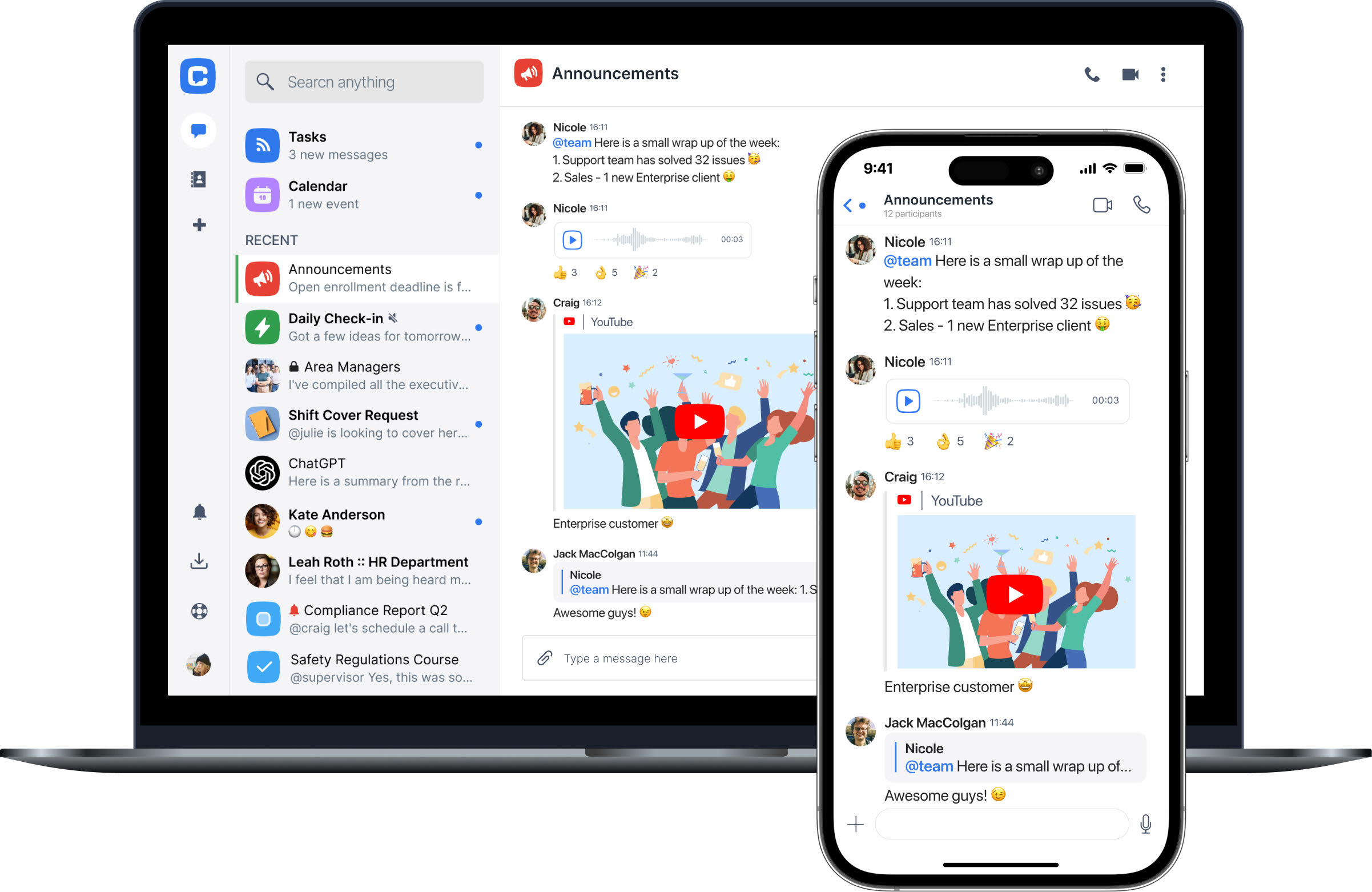
Corporate life is noisy. Constant pings, scattered tools, missed updates, and too many meetings about meetings. Chanty was built to calm that chaos. No clutter. No bloated features. Just a straightforward communication hub your team can actually enjoy using.
Your team’s quiet, connected center
At its heart, Chanty is a team chat app. But it does more than deliver messages. It brings together notifications from Trello, Google Drive, Zendesk, Mailchimp, and other tools you rely on daily. So instead of flipping between tabs or searching through your inbox, you get everything in one place. It becomes the pulse of your workspace, steady and easy to follow.
A private space, not a noisy open floor
Tired of noisy public channels or irrelevant messages from people outside your team? Chanty keeps things simple and secure. No spam, no random invites. Just focused conversations within your team. Whether it’s one-on-one chats, private threads, or group discussions, everything stays clean and distraction-free.
Talk when typing isn’t enough
When writing a message won’t cut it, you can instantly switch to a voice or video call. No need to jump between apps or wait for a meeting link. You can even dial landlines and mobile numbers worldwide, which is great for clients or teammates who aren’t online.
From chat to checklist, instantly
How often does “I’ll take care of it” get lost in chat history? With Chanty, every message can turn into a task. Use the built-in Kanban board to assign, prioritize, and track work without leaving the conversation. This keeps momentum going and prevents things from slipping through the cracks.
Built to reduce distractions, not add to them
Unlike many “free” tools, Chanty doesn’t make money off your attention. That means no ads, no banners, and no pop-ups. Just a clean, calm interface that helps your team stay focused and productive.
Who it’s perfect for
If you’re part of a small or mid-sized team juggling a lot but tired of overcomplicated platforms, Chanty is your kind of tool. It’s easy to set up, intuitive to use, and powerful enough to keep your communication and tasks flowing. For lean teams that want to move fast without the mess, Chanty makes work feel lighter.
Slack
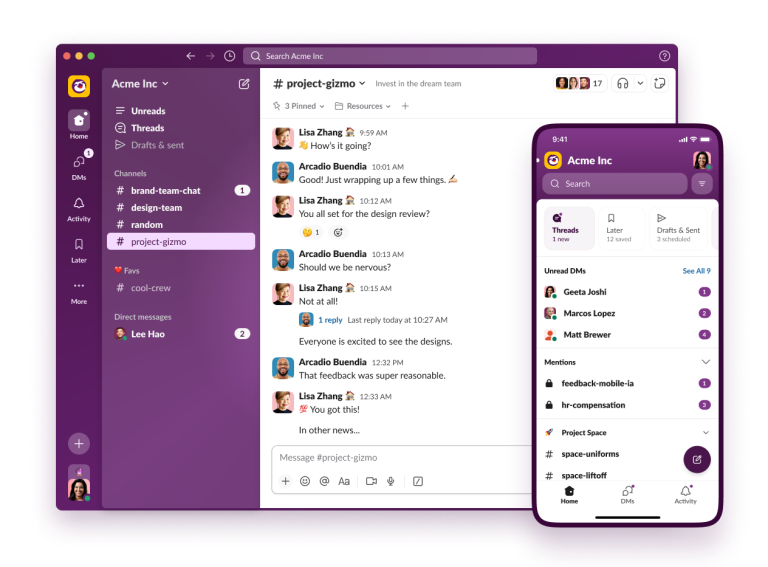
Slack set out to replace email. In most companies, it did. But in the process, it created another kind of noise — perpetual pinging, disconnected conversations, and the constant pressure to be online all the time. And yet, Slack is one of the best-known business comms platforms around.
Real-time communication with flexibility
Slack’s messaging is fast, flexible, and easy to use. You can keep discussions organized with threads, reactions, mentions, and DMs. From planning a product launch to sharing a team meme, it fits your process. Notifications can be customized, but many report that they feel overwhelming. Presence indicators make remote work feel more connected.
A leader in integrations
Slack is also popular for having a huge list of integrations. You can connect tools like Google Drive, Salesforce, GitHub, and a few more. It is thus an accessible option for teams that live across multiple platforms. For developers, marketers, and technical teams, this single-click workflow is a no-brainer advantage.
Calls and huddles for instant connection
Slack has native support for voice and video calls directly within the app. It also offers “huddles,” short, informal audio chats. These are great for ad hoc syncs or sharing a screen. Slack’s video functions, however, are not quite as slick as specialist applications such as Zoom or Microsoft Teams. They do function, but are rather a handy add-on feature than a core function.
Smooth experience across devices
Slack is both desktop and mobile, syncing messages and files in real time. It’s a reliable choice for hybrid and remote teams that need access to conversations anywhere, anytime.
Search and message history — with limits
Slack’s search is wonderful, especially when your workspace is populated with conversations. But on the free plan, access to message history is limited. This can be frustrating for teams that need to refer back to earlier conversations or decisions time and again.
Security and admin control
Slack also has strong admin and security features, but only in its business-level pricing tiers. Admins can manage user authentication, access control, and data retention policies. They are useful tools, but require a higher-tier subscription to use them to their full potential.
Where it works best
Slack thrives in fast-paced, tech-focused settings where integrations, openness, and customization matter the most. For small teams or companies tracking costs, Slack might be too complicated. Its free version constraints — especially in search and storage — will often force groups to upgrade sooner than they need to.
Microsoft Teams
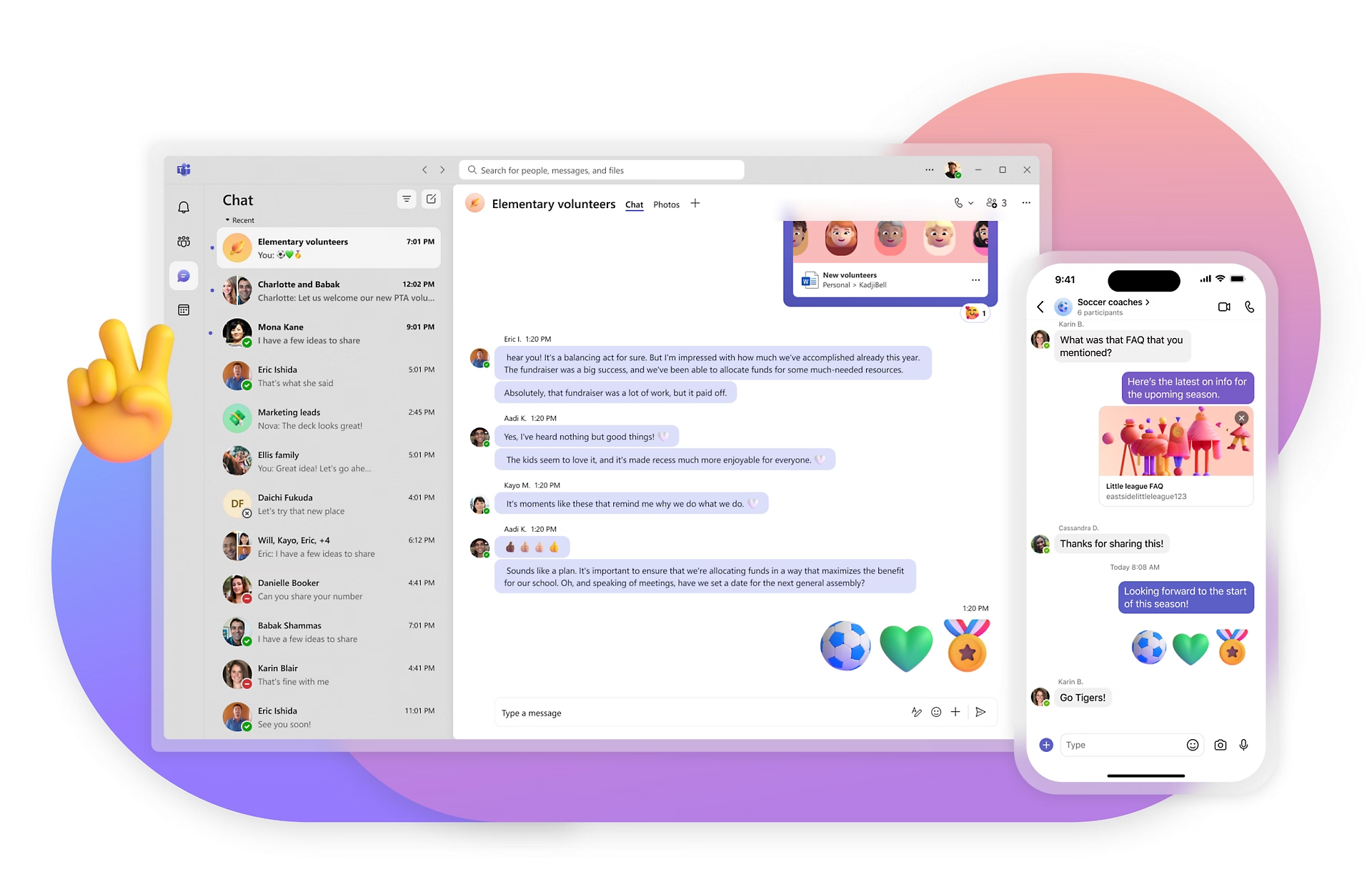
Microsoft Teams is more than a messaging app. It’s a full digital workplace. Built into the Microsoft 365 platform, it’s less concerned with casual chat and more with providing organization, security, and deep integration. For companies, compliance-intensive industries, and IT-managed environments, Teams offers a good foundation. It isn’t always an easy platform to work with, though.
A deeply connected workplace
At its strongest, Microsoft Teams is an extension of your business’s fundamental systems. It works seamlessly with Outlook, SharePoint, OneDrive, Excel, Word, PowerPoint, and even Viva. You can switch from a calendar invitation to a video call to collaborating on a document without departing an app. To companies already running on Microsoft, this coherence of experience is a big win.
Messaging and meetings all in one place
Teams supports one-on-one chat, group chat, and threaded discussions. The real-time chat is consistent but occasionally hard to get to right away. Where Teams shines is in its video conferencing capabilities. It supports large meetings, live events, screen sharing, and breakout rooms all with an enterprise-ready interface. You can even call landlines and cell phone numbers, making it an all-encompassing communications package.
In-built task and project tools
Teams is more than just discussion. You can also create and maintain tasks, monitor progress, and organize with Microsoft Planner and To Do. The interface is a bit of an adjustment, but after your team gets used to it, you can eliminate multiple stand-alone tools with this one platform.
Smart search and document storage
Teams offers full search functionality, such as threaded context and document previews. Nothing is ever lost since everything is safely stored through SharePoint and Exchange. Such reliability is essential for businesses with a need for documentation and compliance.
Control and compliance-centric design
Teams was built with IT teams in mind. It has end-to-end encryption, role-based permissions, data loss prevention, and global compliance rules. Retention settings, usage reports, and security controls are managed comprehensively by admins. It’s a control-focused platform.
Where it can be challenging
The user experience. It can be slow and busy, especially for someone who is not highly technologically literate. It’s time-consuming to get around, and essential notifications are easy to overlook. Smaller teams will get bogged down in features and tabs they don’t really need.
Best for structured enterprise use
Microsoft Teams is a good option for large organizations that are already on Microsoft 365. It is suitable where structure, compliance, and integration are necessary. Yet, for new startups or innovative teams that require a lightweight solution, it can be too heavy and complicated.
Google Workspace (Google Chat & Meet)
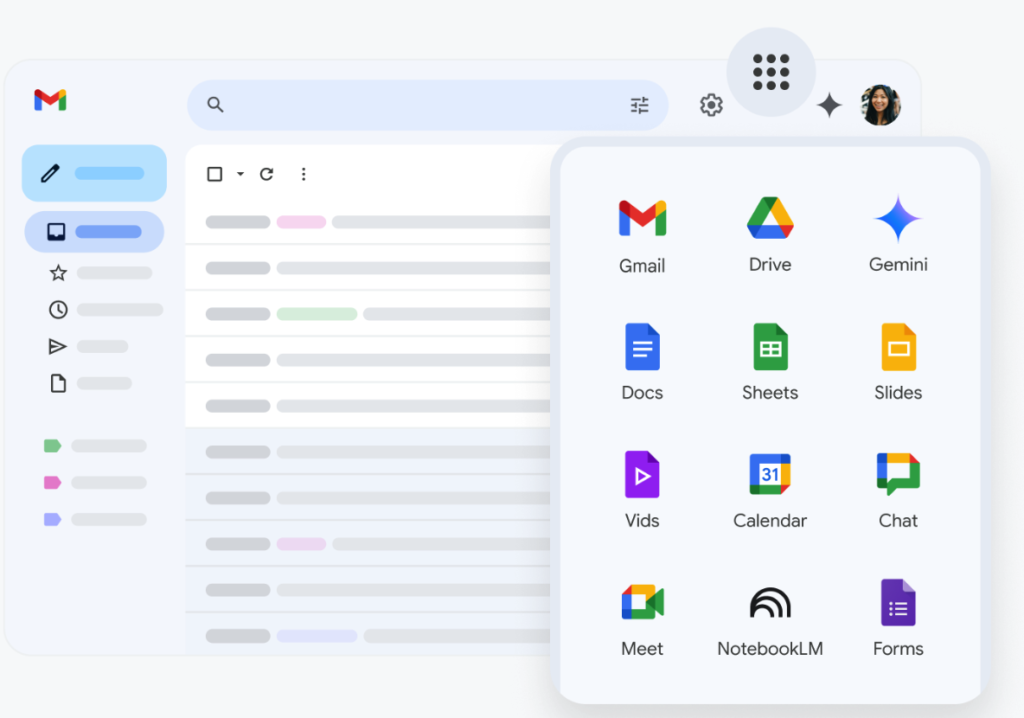
Google Workspace is a productivity suite and more. It’s a cloud platform that is aimed at allowing real-time collaboration. At its center are Google Meet and Google Chat, which keep the team connected through video and messaging. Integrated with Docs, Sheets, and Drive, the platform makes it easy to co-create, share, and communicate. Its best feature is its ease and wide availability, especially for teams already deep in the Google ecosystem.
Communication and collaboration that just flows
Google Chat offers threaded messages, one-on-one conversations, and group rooms that are easy to use. It’s built right into Gmail, Calendar, and Drive, so you can move from chat to file or calendar invite without leaving your platform. For teams who spend most of their day living in their inbox or cloud storage, this kind of integration just keeps things flowing.
Seamless video calling using Google Meet
Google Meet offers video and voice calling with helpful features like screen sharing, background blur, and live captions. It’s built for speed and reliability, even on slower internet qualities. For remote and distributed teams, it allows communication to stay firm without technical glitches.
Collaboration on documents in real time
One of Google Workspace’s strongest points is real-time editing in Docs, Sheets, and Slides. The whole team can go into a document at the same time, collaborate on editing, and see changes as they happen. With commenting, suggestions, and version history, collaboration is always transparent and obvious.
Mobile and multi-device ready
Google’s apps are available on desktop, tablet, and mobile with easy-to-use interfaces. It all synchronizes in real time, which is especially valuable for hybrid teams and workers who are on the move.
Fast, cloud-based search and archive
Using Google’s search technology, old messages, files, or calendar invites are easy to find quickly. It’s all in the cloud, and the product has strong archiving and retention capabilities to ensure your work is always accessible and secure.
Built-in security and admin control
Google Workspace includes enterprise-grade security features like two-factor authentication, admin roles, data loss prevention, and compliance with major standards like GDPR and HIPAA. Teams can manage file sharing and access controls granularly to suit their security needs.
Things to recall
Google Chat and Meet are adequate for everyday communication but don’t have the feature depth of something like Slack or Microsoft Teams. There is no built-in task management or project planning beyond the essentials, so most teams rely on outside tools for workflows. And for businesses not fully invested in Google’s ecosystem, integrations with third-party services might appear limited.
Best for teams already in the Google world
Google Workspace is a great match for groups already utilizing Gmail and Google Drive, especially those specializing in document collaboration and basic communications. It’s a favorite for educators, content developers, and knowledge teams who value simplicity and real-time collaboration.
Zoom
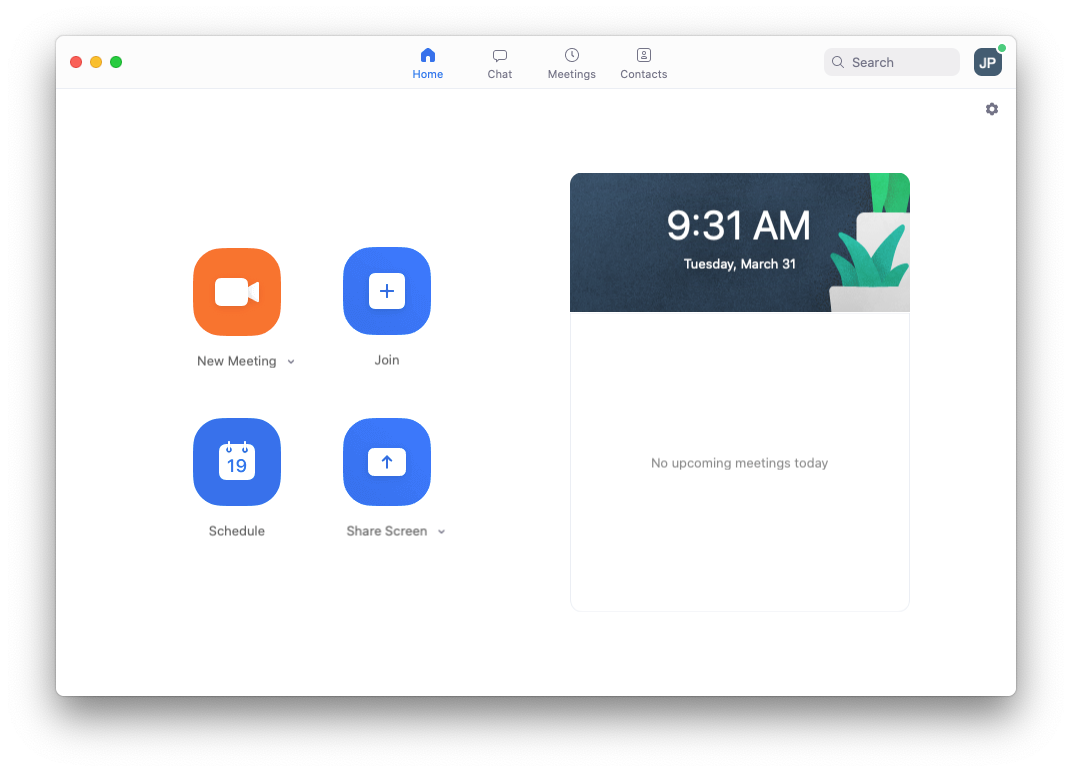
Zoom was originally designed as a video conferencing solution and has since grown to become a more general purpose communications platform. It’s especially renowned for its rock-solid, high-definition video and audio, which has made it one of the top virtual meeting, webinar, and remote work solutions in numerous sectors.
Clear, stable video and voice
Zoom’s strongest feature is its solid-as-a-rock, clean video and voice calls. It excels at everything from quick one-on-one check-ins to massive webinars and corporate town halls. With virtual backgrounds, breakout rooms, and reaction buttons, meetings feel more engaging — even when everyone is working remotely.
More than meetings with Zoom Team Chat
In order to facilitate ongoing communication between calls, Zoom introduced Team Chat. It has permanent chat rooms, private chat, file sharing, and threaded reply. While it doesn’t have Slack’s and Microsoft Teams’ level of features, it works well with Zoom’s video platform and enables fewer apps to be switched between.
Collaboration and integration tools
Zoom provides useful add-ons like digital whiteboards, meeting recordings with search-pendent transcripts, and integrations with tools like Google Workspace, Microsoft Teams, and Slack. These tools allow teams to organize themselves, share insights, and follow up easily after meetings.
Works on all your devices
Zoom is available across desktop, tablet, and mobile with automatic synchronization so you never miss an email or a meeting. The mobile app is light and simple, ideal for team members who are often on the go.
Chat history and cloud storage
Zoom records meetings and chat discussions in the cloud, enabling teams to reference back and review important details. But the search feature is decently straightforward, which can be less effective for locating specific information buried within busy chat streams or bigger organizations.
Security and privacy features
Zoom has evolved significantly in improving its security. It now includes functionalities like end-to-end encryption, waiting rooms, passcodes, and admin-level controls. However, for those businesses that are highly regulated with very strict compliance requirements, some additional configurations or integrations may be necessary.
Where it works and where it doesn’t
Zoom is a great fit for teams that prioritize video communication. It supports smooth, professional meetings and works well in areas where face-to-face connection is the utmost priority. But for project management and task tracking, as well as messaging, it is not as complete as comprehensive platforms such as Microsoft Teams or Slack. For video-intensive teams, Zoom works well. For people seeking a fully integrated collaboration environment, it may need to be part of a broader suite of tools.
RocketChat
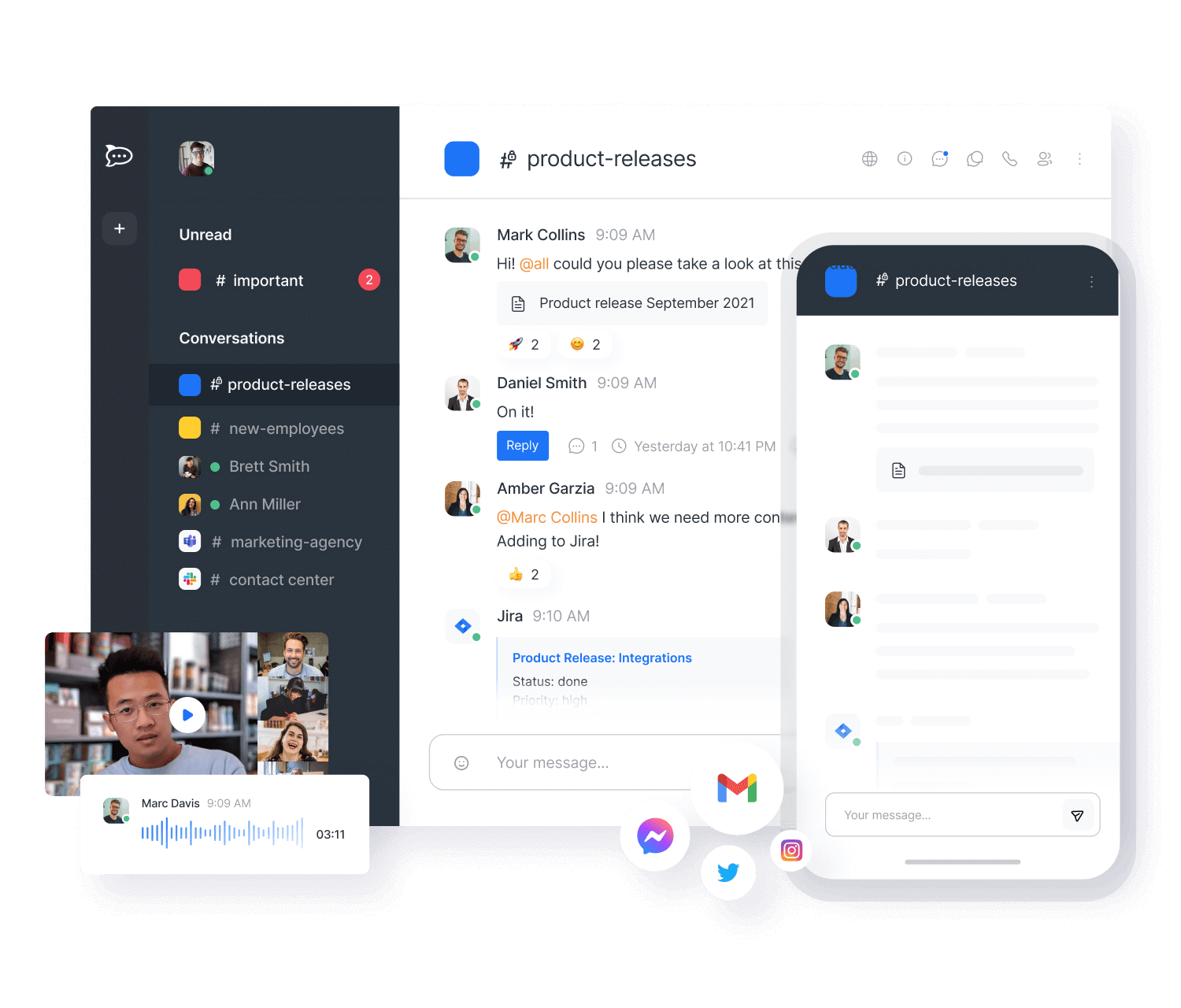
Rocket.Chat is a highly customizable, open-source communication platform with a mission of bringing control back to the hands of businesses. It’s widely used by teams that prioritize security, privacy, and flexibility, especially those that need or prefer to self-host or require high levels of customization.
Open-source and freedom to self-host
Unlike most proprietary solutions, Rocket.Chat also offers self-hosting, allowing businesses to have full control of security settings, data, and customization. This is highly appealing to industries with strict compliance needs, like healthcare, government, and finance, where sovereignty over data matters.
Powerful messaging and collaborative capabilities in real time
Rocket.Chat offers support for group chat, threaded discussion, sharing files, and mentions, all within an extremely customizable interface that can meet brand and workflow preferences. Its real-time chat is solid and includes features like reaction, emojis, and rich text formatting.
Voice, video, and even phone calls
Rocket.Chat supports voice and video calls out of the box, allowing teams to seamlessly transition from chat to real-time conversation. It also supports SIP and PSTN, so calls to landlines and mobiles are possible, a plus for teams with digital and analog comms.
Flexible integrations and bots
With a wide range of integrations — anything from GitHub to Jira — and being able to create custom bots and workflows, Rocket.Chat can be tightly integrated with existing systems. This means that it’s a good fit as a technical team and organization communications platform with complex communication needs.
Search and archiving capabilities
Rocket.Chat features comprehensive message searching, archiving, and audit logs, which are critical for compliance and knowledge management purposes. Users can quickly find past conversation and shared documents, with nothing slipping through the cracks.
Security and access control
Security is inherent in the form of end-to-end encryption, multi-factor authentication, role-based granular access, and advanced admin controls. Teams can share confidential information with peace of mind knowing their platform is secured.
Where it shines and where it falls short
Rocket.Chat’s greatest strength is its flexibility and ownership, but with a price. The installation and upkeep might require a great deal of technical sophistication. Small or non-technical teams will find the learning curve too high and the interface less polished than mass-market alternatives.
Best for.
Firms that value data control, customization, and security above all else — especially regulated industries or organizations with in-house IT support. It’s a Swiss army knife for folks who need to customize their communications environment just so.
Cisco Webex
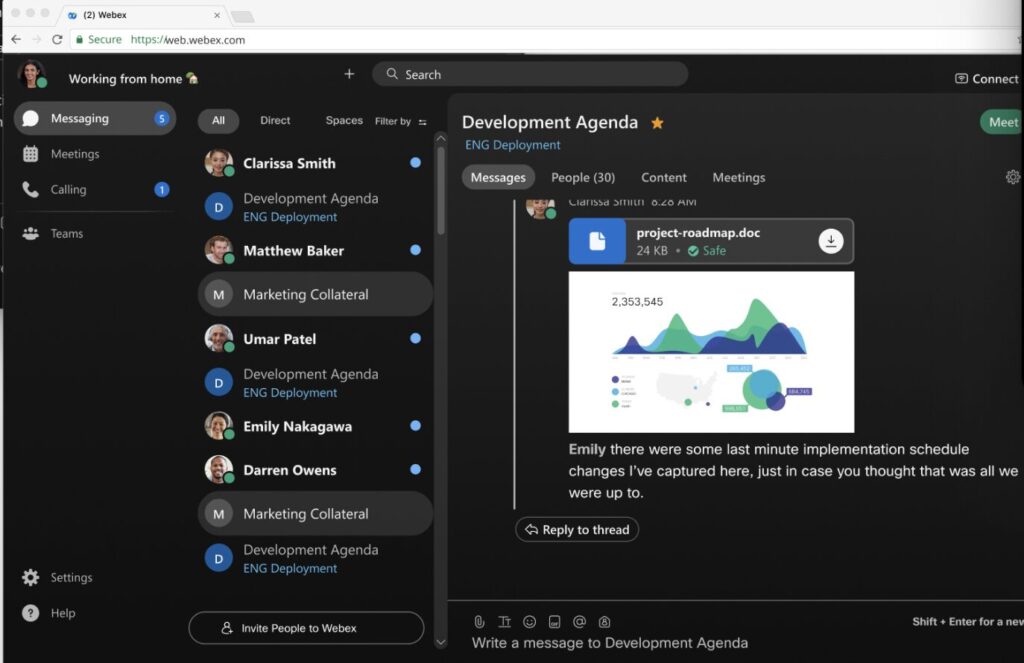
Cisco Webex is an established player in business communications, and it has been trusted for reliable video conferencing and strong security features. It is meant to cater to the needs of large-scale organizations with scalable, secure, and dependable collaboration tools.
Professional-quality video and voice experiences
Webex provides high-definition video meetings, webinars, and virtual events. It has the capability to host anything from spontaneous check-ins to large, huge sessions involving thousands. Breakout rooms, live polls, captioning, and AI-driven noise cancellation all help teams have superior, uninterrupted meetings, even in complex or formal settings.
Messaging and collaboration between meetings
Webex has team messaging through its Webex Teams feature. Messages, files, whiteboard ideas, and simple tasks are sent and shared in a persistent space by users. Conversation is organized as group rooms or threaded conversation areas, enabling teams to stay current beyond normal meetings.
Integrations and workflow customization
Webex supports integration with a vast array of business applications like Microsoft 365, Google Workspace, Salesforce, and Slack. Teams with special needs are offered open APIs from Webex, through which the capabilities can be embedded or business processes automated. This kind of flexibility is highly beneficial in very structured IT infrastructures.
Works seamlessly on any device
Webex applications are designed to operate on a regular basis on desktops, mobiles, and tablets. Your remote, hybrid, or always-on-the-move employees can just stay connected and keep working irrespective of their locations.
Search, archiving, and compliance support
With its strong search and cloud storage, Webex lets teams quickly find past conversations and documents. It is HIPAA, GDPR, and FedRAMP compliant and lets admins place custom retention policy, monitor activity, and apply data governance policy.
Security and administrative control
Cisco Webex is security-focused. It supports end-to-end encryption, multi-factor authentication, and role-based access controls. All of these technologies make it a secure product to work with for organizations handling sensitive or confidential information.
What to consider
While Webex is strong in features, sophistication could be overwhelming for smaller companies or groups who don’t want anything too complex. Installation and interface take time to get the hang of, and price could be more than alternatives, possibly excluding budget-conscious teams.
Best for corporate needs
Cisco Webex is better suited for big businesses, government departments, and heavily regulated sectors needing a secure richly featured communication platform. It offers consistency and control at scale. It might be too heavy for startups or agile teams who need a lightweight platform.
Nextiva
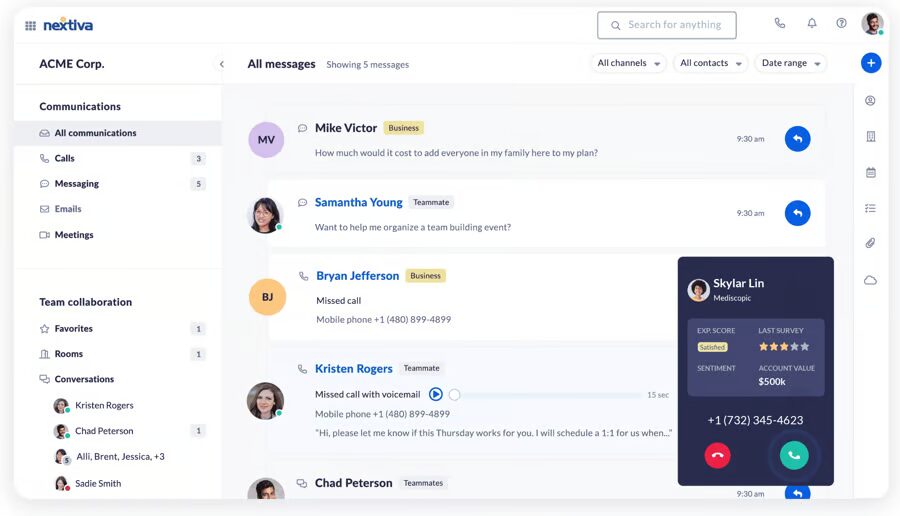
Nextiva is an all-in-one business communication platform that unifies voice, video, messaging, and collaboration tools into one place. It’s especially popular with small to mid-sized businesses that need a simple solution with enterprise-level reliability.
One point of contact for growing teams
Nextiva brings voice calls, video conferencing, team chat, and voicemail together in one platform. This does away with the need for apps and makes it simple for teams to consolidate communication. It is all accessible in one place, making it easy and efficient to maintain.
Strong voice capabilities at its foundation
Nextiva is known for its cloud VoIP phone system. It features unlimited call in the U.S. and Canada, and the services include features like call forwarding, voicemail transcription, and auto-attendants. Teams can even dial out mobile and international landline numbers, so it is a strong competitor to the traditional telephones.
Video meetings and messaging included
The system is also HD video conferencing enabled with screen share and recording. Team messaging is installed, and private conversations and group channels are enabled. The chat features aren’t as robust as those offered by Slack or Microsoft Teams but will do the job for quick, straightforward communication.
Works with your current tools
Nextiva also synchronizes with the most popular CRM systems like Salesforce and HubSpot to get customer conversations and data harmonized within teams. It also synchronizes with Outlook and Google Workspace to connect calendars, emails, and contacts in one place.
Same experience everywhere
Either desktop or mobile, Nextiva brings your team together. The iOS and Android apps allow users to access calls, messages, and meetings wherever they are working, ideal for remote or hybrid workers.
Secure and reliable for business use
Nextiva provides enterprise-level security with SRTP and TLS encryption, role-based access control, and 99.999% uptime. It is compliant with data protection regulations like HIPAA and GDPR, which is especially important for sectors that deal with sensitive information.
What to remember
Because Nextiva is highly voice and video-focused, its messaging and collaboration capabilities fall behind. Groups requiring detailed task management, automation, or broad third-party app integration may find it too rigid compared to other tools such as Teams or Slack.
Best for teams that rely on voice
Nextiva is a suitable solution for small and medium businesses that need trusted phone communication and would like to have all integrated into one platform. It is specially useful for sales, support, and service businesses that need trusted calling with the option of chat and video as well.
Flock

Flock brings messaging, video calls, and integrated productivity tools under one easy-to-use platform. Designed to make it easy for teams to communicate, collaborate, and get organized without leaving a dozen apps behind.
Simple, instant team messaging
Flock has threaded conversations, direct messaging, and public and private channels. The clean, minimalistic design ensures that it is easy to keep track of conversations, a welcome respite for teams tired of struggling with overly complex communication platforms.
Ease with voice and video calls
Flock has in-built voice and video calls allowing you to easily move from chat to live conversation. Screen sharing and recording of meetings enable you to work remotely effortlessly. It is ideal for teams that need instant, lightweight video conferencing without having to leave the workspace.
Built-in productivity tools
Apart from chat, Flock supports task lists, shared notes, polls, and reminders. All of these enable teams to go straight from discussing to doing without having to bounce back and forth between many applications. It simplifies working together and reduces the distraction of broken productivity tools.
Works with your day-to-day tools
Flock is integrated with tools like Google Workspace, Trello, and GitHub, and allows the teams to take their favorite tools into a single environment. All these integrations automate mundane repetitive work and keep your processes consistent.
Mobile and desktop access
From your workspace or while on-the-go, Flock keeps you connected. The application runs seamlessly on desktop and mobile devices with instant syncing of notifications so nothing is ever lost.
Organized communication and powerful search
Smart search enables instant retrieval of past messages, links, or files exchanged. Channels and threaded conversations keep things in order, even for teams with multiple projects simultaneously.
Security and admin controls
Flock possesses important security features such as data encryption, single sign-on, and permission based on roles. While it lacks some of the necessary certifications for highly regulated sectors, it is adequate for most small and mid-sized enterprises.
Strengths and limitations
Flock is a suitable choice for those teams that need an easy, one-stop communication platform with valuable integrated features. However, larger enterprises or those demanding deeper customizations may find it less adaptable than more mature platforms.
Best for small to mid-sized teams
Flock is an appropriate option for businesses that require a tidy, simple workspace where chat, meetings, and task management all coexist. It removes the noise and keeps the focus on getting tasks done without further complication.
Discord
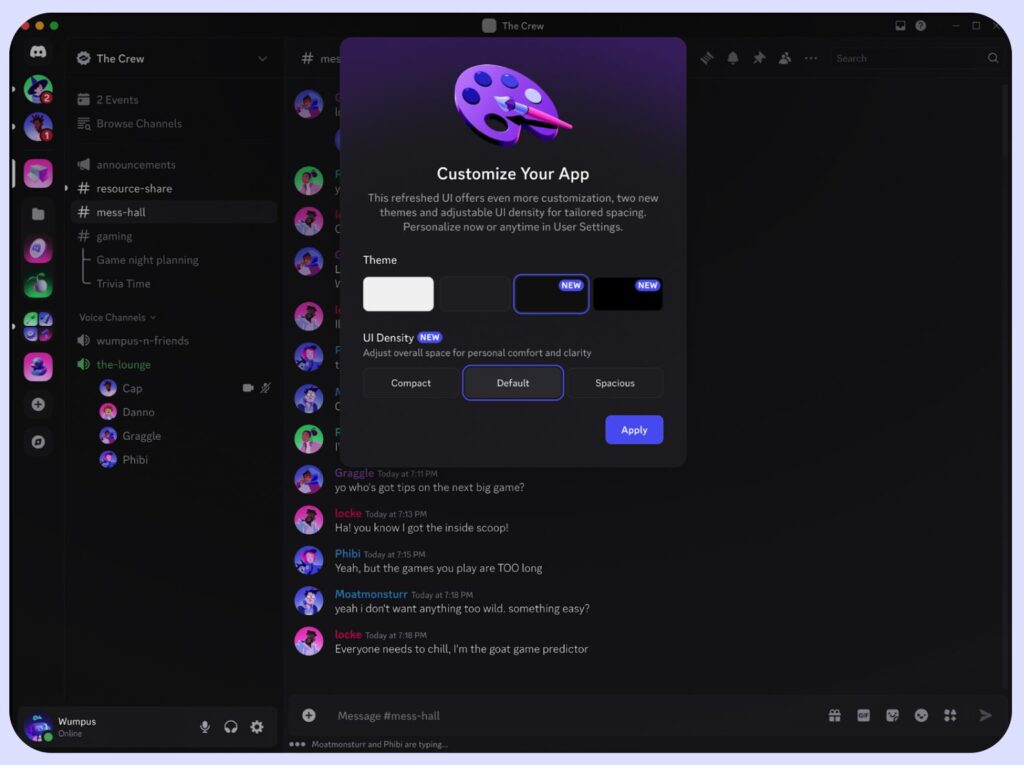
Discord started out as a gaming platform but has since become a versatile communication solution employed by creative teams, remote startups, and online communities. Its strength lies in real-time communication via voice, video, and text, presented in a highly flexible interface.
Flexible communication for fast-speed teams
Discord features always-available voice channels, category-based text channels, and direct messages that enable seamless jumping into conversations at any moment. This relaxed and open layout supports both formal updates and spontaneous conversations, creating an incredibly interactive team environment.
Reliable voice and video interaction
Voice chat is where Discord truly shines. It offers low-latency, high-fidelity voice chat that holds up well even in large groups. Video conferencing, screen sharing, and streaming to large numbers of users supplement its real-time functionality, perfect for brainstorming, quick syncs, or creative demos.
Custom bots and integrations
While Discord isn’t business-oriented, it does support a wide range of bots and plug-ins that can automate anything, moderate channels, or offer useful functionality. They can streamline the workspace but usually require technical setup. In contrast to Slack or Teams, most features are community-created extensions rather than native support.
Smooth cross-device experience
Discord can be found on nearly every platform like Windows, macOS, Linux, iOS, and Android. It saves messages and media between devices so that your team is connected whether at the office or away. Mobile experience is especially smooth for collaboration on-the-go.
Message history and search tools
Discord has search capabilities to allow quick access to older messages, links, or files. However, in very crowded and active servers, finding older content can become cumbersome at times. Channels organized with clear titles reduce the messiness and maximize visibility.
Security and privacy basics
Discord has fundamental security attributes like two-factor authentication and encryption. Yet, it lacks more advanced compliance certifications required by sectors such as government, finance, or healthcare, which would be a letdown for teams with stricter privacy demands.
Where Discord excels and where it may go wrong
Discord is ideal for creative teams, remote-first teams, or startup cultures where conversation is voice-first, high-speed, and informal. It also works well in teams that thrive on community-style interaction. It lacks built-in task management, formal workflows, and enterprise-level controls and therefore makes no sense in traditional corporate environments.
Ideal for teams that love casual collaboration
Discord is a great choice for small, creative, or distributed teams who need a fun and flexible space to interact. Discord can support community and real-time communication but may not be the best fit for organizations that need formal procedures, detailed reporting, or regulation-friendly features.
Quick comparison table of top communication platforms
| Platform | Core Strength | Best For | Pricing (Starting at) |
| Chanty | Simple team chat + built-in task management, voice & video, including landline calls | Small & growing teams craving clarity and flow | Free plan available; Paid from $4/user/month (billed annually) |
| Slack | Feature-rich messaging, thousands of integrations, flexible workflows | Tech-savvy fast-moving teams | Free plan available; Paid from $8.75/user/month (Standard Plan) |
| Microsoft Teams | Enterprise collaboration with deep Microsoft 365 integration & PSTN calling | Large enterprises on Microsoft 365 | Included with Microsoft 365 Business Basic $6/user/month; Teams Essentials $4/user/month standalone |
| Google Workspace | Real-time collaboration with seamless Google app integration & Meet video calls | Teams embedded in Google ecosystem | Plans start at $6.30/user/month (Business Starter) |
| Zoom | Industry-leading video conferencing + basic team chat | Video-first teams and webinars | Free basic; Paid Pro plan from $13.33/month (per host) |
| Rocket.Chat | Open-source, customizable, self-hosting option, strong security | Security-conscious organizations | Free self-hosted; Paid plans for custom price |
| Cisco Webex | Scalable secure video & messaging for regulated industries | Large enterprises and regulated industries | Free basic; Paid plans from $22.50/user/month (Webex Suite) |
| Nextiva | Cloud VoIP with unified messaging and video | SMBs needing reliable phone & video | Plans start at $30/user/month (Core Plan) |
| Flock | Simple, clean messaging with built-in productivity tools | Small to mid-sized teams wanting all-in-one simplicity | Free plan available; Paid from $4.50/user/month (Pro Plan) |
| Discord | Voice-first, real-time chat with community focus | Creative teams and informal groups | Free; Nitro subscription $9.99/month or $99.99/year (optional) |
Final thoughts
In a world today where teams are spread out across time zones, inboxes fill up before lunch, and attention is pulled a hundred different directions, communication tools have become more than utilities. They’re not just ways to talk — they’re how we coordinate, how we align, how we stay human while figuring out the digital rhythm of work.
As we’ve said, these tools can bring order to chaos. They keep us current, informed, in touch — whether we’re steering a project, checking in with a colleague, or catching up on decisions that were made during our sleep. They reduce friction, keep us on task, and, perhaps most of all, create space for actual collaboration in the cacophony of the modern workday.
We’re not just adopting new platforms — we’re redefining how collaboration looks and feels.
And in that redefinition, tools like Chanty step in — not to overwhelm, but to simplify. Not to distract, but to align. Built for teams that want speed without complexity, structure without rigidity, and connection without burnout.
So, if your team is still toggling between five tools to do one thing, maybe it’s time to rethink your communication stack. Because the right tools don’t just help you talk — they help you work better, lead better, and feel better doing it.








